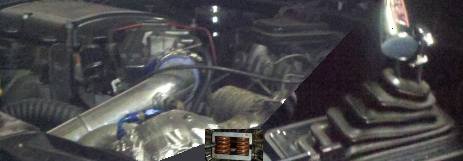The firing order of my 1987 Beretta firing order jumped timing?
The firing order of my 1987 Beretta firing order jumped timing?
One of my friends who is an avid car mechanic told me that there is a chance my firing order jumped timing. The firing order is 1-4-6-3-2-5 and the engines pistons read 1-3-5 in the back from left to right and 2-4-6 left to right in the front. The only way for my car to actually start roughly is when it is plugged in where the piston numbers are reversed. where its 2-4-6 in the back left to right and 1-3-5 in the front left to right. I am trying to get it run smoothly and have no problems. I changed out the sparkplugs to where they are clean and there is nothing wrong with the plugwires since they are all sparking properly when checked. This is the first car im repairing and i am in a pickle please help
-
Cliff8928
- Administrator
- Posts: 1775
- Joined: Wed Mar 03, 2004 10:03 pm
- Location: Long Grove, IL
- Contact:
Re: The firing order of my 1987 Beretta firing order jumped timing?
The actual firing order of the engine is 1-2-3-4-5-6. The 1-4 6-3 2-5 is just how the wires are attached to the coils due to the waste-spark ignition.
GM wrote: Electronic Ignition (EI) System
The electronic ignition system controls fuel combustion by providing a spark to ignite the compressed air/fuel mixture at the correct time. To provide optimum engine performance, fuel economy, and control of exhaust emissions, the PCM controls the spark advance of the ignition system. Electronic ignition has the following advantages over a mechanical distributor system:
• No moving parts.
• Less maintenance.
• Remote mounting capability.
• No mechanical load on the engine.
• More coil cool down time between firing events.
• Elimination of mechanical timing adjustments.
• Increased available ignition coil saturation time.
The electronic ignition system does not use the conventional distributor and coil. The ignition system consists of three ignition coils, an ignition control module, a camshaft position sensor, 2 Hall-effect crankshaft position sensors, an engine crankshaft balancer with interrupter rings attached to the rear, related connecting wires, and the Ignition Control (IC) and fuel metering portion of the PCM.
Conventional ignition coils have one end of the secondary winding connected to the engine ground. In this ignition system, neither end of the secondary winding is grounded. Instead, each end of a coil's secondary winding is attached to a spark plug. Each cylinder is paired with the cylinder that is opposite it (1-4, 2-5, 3-6). These two plugs are on companion cylinders, i.e., on top dead center at the same time.
When the coil discharges, both plugs fire at the same time to complete the series circuit. The cylinder on compression is said to be the event cylinder and the one on exhaust is the waste cylinder. The cylinder on the exhaust stroke requires very little of the available energy to fire the spark plug. The remaining energy will be used as required by the cylinder on the compression stroke. The same process is repeated when the cylinders reverse roles. This method of ignition is called a waste spark ignition system.
Since the polarity of the ignition coil primary and secondary windings is fixed, one spark plug always fires with normal polarity and its companion plug fires with reverse polarity. This differs from a conventional ignition system that fires all the plugs with the same polarity. Because the ignition coil requires approximately 30% more voltage to fire a spark plug with reverse polarity, the ignition coil design is improved, with saturation time and primary current flow increased. This redesign of the system allows higher secondary voltage to be available from the ignition coils - greater than 40 kilovolts (40,000 volts) at any engine RPM. The voltage required by each spark plug is determined by the polarity and the cylinder pressure. The cylinder on compression requires more voltage to fire the spark plug than the one on exhaust.
It is possible for one spark plug to fire even though a plug wire from the same coil may be disconnected from its companion plug. The disconnected plug wire acts as one plate of a capacitor, with the engine being the other plate. These two capacitor plates are charged as a spark jumps across the gap of the connected spark plug. The plates are then discharged as the secondary energy is dissipated in an oscillating current across the gap of the spark plug that is still connected. Secondary voltage requirements are very high with an open spark plug or spark plug wire. The ignition coil has enough reserve energy to fire the plug that is still connected at idle, but the coil may not fire the spark plug under high engine load. A more noticeable misfire may be evident under load; both spark plugs may then be misfiring.
Cliff Scott


- 3X00-Modified
- Administrator
- Posts: 10912
- Joined: Thu Jul 05, 2007 9:18 am
- Location: Brooklyn CT
Re: The firing order of my 1987 Beretta firing order jumped timing?
Also if your car "jumped timing" as you friend suggested... The only thing that would change is the relationship between the cam and crank, which would result in valves hitting pistons. Spark timing is picked up off of notches machined in the crank so it can never "jump" from its intended position. It's not like a distributor drive setup.
Re: The firing order of my 1987 Beretta firing order jumped timing?
ok thank you for your help  I still need to figure out why its running roughly.
I still need to figure out why its running roughly.
Re: The firing order of my 1987 Beretta firing order jumped timing?
Intake port runners cross sides and oppose it's supporting ex-chamber.
_________

-------------
-------------